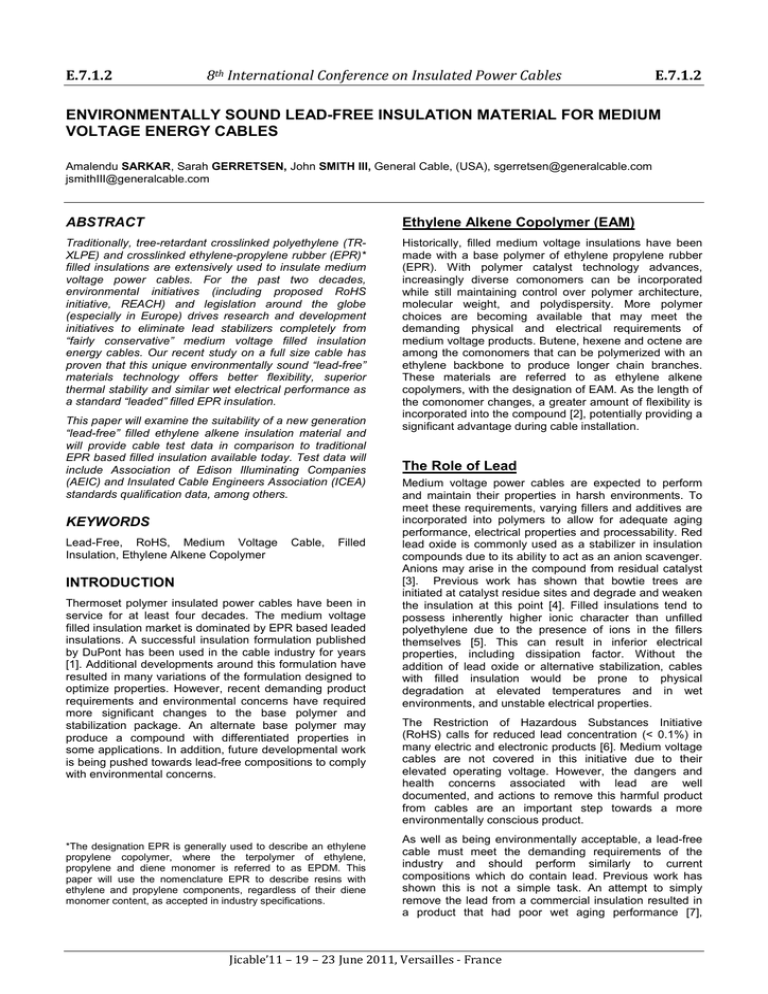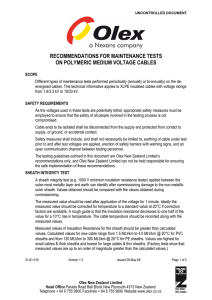E.7.1.2 8th International Conference on Insulated Power Cables E
advertisement

E.7.1.2 8th International Conference on Insulated Power Cables E.7.1.2 ENVIRONMENTALLY SOUND LEAD-FREE INSULATION MATERIAL FOR MEDIUM VOLTAGE ENERGY CABLES Amalendu SARKAR, Sarah GERRETSEN, John SMITH III, General Cable, (USA), sgerretsen@generalcable.com jsmithIII@generalcable.com ABSTRACT Ethylene Alkene Copolymer (EAM) Traditionally, tree-retardant crosslinked polyethylene (TRXLPE) and crosslinked ethylene-propylene rubber (EPR)* filled insulations are extensively used to insulate medium voltage power cables. For the past two decades, environmental initiatives (including proposed RoHS initiative, REACH) and legislation around the globe (especially in Europe) drives research and development initiatives to eliminate lead stabilizers completely from “fairly conservative” medium voltage filled insulation energy cables. Our recent study on a full size cable has proven that this unique environmentally sound “lead-free” materials technology offers better flexibility, superior thermal stability and similar wet electrical performance as a standard “leaded” filled EPR insulation. Historically, filled medium voltage insulations have been made with a base polymer of ethylene propylene rubber (EPR). With polymer catalyst technology advances, increasingly diverse comonomers can be incorporated while still maintaining control over polymer architecture, molecular weight, and polydispersity. More polymer choices are becoming available that may meet the demanding physical and electrical requirements of medium voltage products. Butene, hexene and octene are among the comonomers that can be polymerized with an ethylene backbone to produce longer chain branches. These materials are referred to as ethylene alkene copolymers, with the designation of EAM. As the length of the comonomer changes, a greater amount of flexibility is incorporated into the compound [2], potentially providing a significant advantage during cable installation. This paper will examine the suitability of a new generation “lead-free” filled ethylene alkene insulation material and will provide cable test data in comparison to traditional EPR based filled insulation available today. Test data will include Association of Edison Illuminating Companies (AEIC) and Insulated Cable Engineers Association (ICEA) standards qualification data, among others. KEYWORDS Lead-Free, RoHS, Medium Voltage Insulation, Ethylene Alkene Copolymer Cable, Filled INTRODUCTION Thermoset polymer insulated power cables have been in service for at least four decades. The medium voltage filled insulation market is dominated by EPR based leaded insulations. A successful insulation formulation published by DuPont has been used in the cable industry for years [1]. Additional developments around this formulation have resulted in many variations of the formulation designed to optimize properties. However, recent demanding product requirements and environmental concerns have required more significant changes to the base polymer and stabilization package. An alternate base polymer may produce a compound with differentiated properties in some applications. In addition, future developmental work is being pushed towards lead-free compositions to comply with environmental concerns. *The designation EPR is generally used to describe an ethylene propylene copolymer, where the terpolymer of ethylene, propylene and diene monomer is referred to as EPDM. This paper will use the nomenclature EPR to describe resins with ethylene and propylene components, regardless of their diene monomer content, as accepted in industry specifications. The Role of Lead Medium voltage power cables are expected to perform and maintain their properties in harsh environments. To meet these requirements, varying fillers and additives are incorporated into polymers to allow for adequate aging performance, electrical properties and processability. Red lead oxide is commonly used as a stabilizer in insulation compounds due to its ability to act as an anion scavenger. Anions may arise in the compound from residual catalyst [3]. Previous work has shown that bowtie trees are initiated at catalyst residue sites and degrade and weaken the insulation at this point [4]. Filled insulations tend to possess inherently higher ionic character than unfilled polyethylene due to the presence of ions in the fillers themselves [5]. This can result in inferior electrical properties, including dissipation factor. Without the addition of lead oxide or alternative stabilization, cables with filled insulation would be prone to physical degradation at elevated temperatures and in wet environments, and unstable electrical properties. The Restriction of Hazardous Substances Initiative (RoHS) calls for reduced lead concentration (< 0.1%) in many electric and electronic products [6]. Medium voltage cables are not covered in this initiative due to their elevated operating voltage. However, the dangers and health concerns associated with lead are well documented, and actions to remove this harmful product from cables are an important step towards a more environmentally conscious product. As well as being environmentally acceptable, a lead-free cable must meet the demanding requirements of the industry and should perform similarly to current compositions which do contain lead. Previous work has shown this is not a simple task. An attempt to simply remove the lead from a commercial insulation resulted in a product that had poor wet aging performance [7], Jicable’11 – 19 – 23 June 2011, Versailles - France
